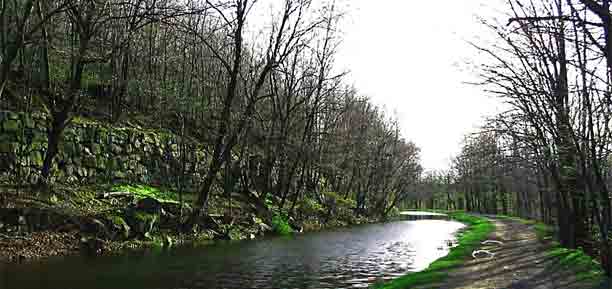Historical Significance
The Morris Canal, New Jersey's Mountain-Climbing Waterway was constructed between 1825 and 1831 and substantially modified between 1845 and 1860. It was the world's highest climbing canal ever built at 1,674 feet, its elevation change dwarfs the Empire State Building by 624 feet. During its operation, it traveled 102 miles from the Hudson River at Jersey City to the Delaware River at Phillipsburg in a general east to west direction. The Morris Canal is listed on the New Jersey and National Registers of Historic Places and is significant as a technological innovation for its time. One of the canal’s greatest achievements was its use of watered powered inclined planes to overcome large elevation changes in climbing the hills of Northern New Jersey. The engineering innovation of the Morris Canal also helped to make possible the industrial revolution by bringing anthracite coal from Pennsylvania to the furnaces of Morris County. The canal was also responsible for increased development along its route, including rejuvenating a failing iron industry in Morris County from the mid to the late nineteenth century.
Lock 2 East was one of 23 traditional locks and 23 inclined planes within the Morris Canal. It overcame an elevation change of 8 feet and was the second lock located east of Lake Hopatcong, the mid-point of the canal and one of the primary water sources for the Canal’s operation.
Although traffic on the Morris Canal had diminished by the 1880s due to an increase in the reliance upon the railroad to transport goods between the coal mines in northeastern Pennsylvania, the forges, mines and foundries of northwest New Jersey, and the industrial plants in northeast New Jersey, cities such as Paterson and Newark; the canal was not officially abandoned until 1924. Upon its abandonment, the State of New Jersey systematically drained the canal and dismantled many of the buildings and structures that were used for the functioning of the planes and locks. Much of what was the canal route today is either in ruin, has been removed from the landscape due to development, or is in some other manner unrecognizable as a remnant of the canal. Lock 2 East, as one of the best-preserved sections of the Morris Canal and featuring a rare portion still partially filled with water, serves as an exception. Although the lock was in-filled including removal of the top few feet of the lock walls, the site retains a high degree of integrity. The Borough of Wharton purchased the lock site, the canal prism and other adjacent properties beginning in 1926 directly from the State. The lock site is part of Hugh Force Park providing passive recreation to area residents. In 1976 the Borough excavated the existing watered portion of the canal in order to restore the canal prism, becoming one of only a handful of sections of the canal prism that reflects its historic appearance.
The Lock 2 East site has an added element to its history having been tended by the Bird family, whose members had a long history with the Morris Canal. Lock 2 East has traditionally been known as “Bird’s Lock,” with several generations of the family, beginning with Welch Bird in the 1860s, acting as lock tender at the site.



